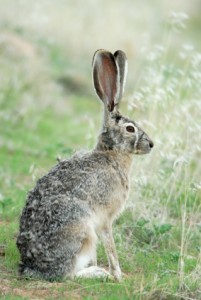Family, Description and Size:
Jackrabbits belong to the genus Lepus and are considered leporids. Jackrabbits are actually hares and thus are larger than Rabbits, have longer ears and have black spots on their gray coats. Their hind legs also tend to be larger than cottontail Rabbits.
They reach a size of up to two feet and a weight of 3 to 9 lbs.
Range and Habits:
Jackrabbits are common in deserts, scrublands and farmlands across America. They can consume very large quantities of grasses and plants including cactuses. Being a threat to a farmer’s crops, they are often considered to be a pest.
There are five species of Jackrabbits found mainly in western and central North America. Two of the most common species are the black-tailed and white-tailed Jackrabbits. Black-tailed Jackrabbits are usually found living in deserts eating shrubs and cacti, while white-tailed Jackrabbits live in the Northern farmlands, forests and prairies. White-tailed Jackrabbits can eat up to a pound of vegetation each day, which is astounding considering their size.
General Information:
Like all hares, the Jackrabbit digs shallow nests and not burrows like most Rabbits. It gives birth to strong young that can fend for themselves early on in life in contrast to the weak offspring of Rabbits.
Hares have large ears which allow them to cool themselves during the summer heat. They are often found tucked into a shady area, out of the direct sun, during the heat of the day. They are speedy animals, reaching a running speed of 40 miles per hour with ease. They can also use their strong and long hind legs to jump up to ten feet in length. Jumping and running in zigzag patterns is the main way the Jackrabbit escapes its predators.
Jackrabbits, like all hares, breed very rapidly. They often have three to four litters every year with one to six young in every litter. The young mature quickly and may start breeding themselves within two or three months. This causes Jackrabbit populations to rise very fast whenever food is abundant and predators scarce. This is most often the case near farms where large predators have been hunted down.
Predators, Mortality and Lifespan:
Jackrabbits are part of many a large predator’s diet. They are hunted by canids like foxes, coyotes and wolves as well as by bobcats and some large birds of prey like owls. Farmers often hunt the Jackrabbits if they are ruining
their crops or they get hunters to do it for them. The Jackrabbit is edible and the meat of young Jack Rabbits is popular among those who eat game.
Even though they are hunted by humans and animals alike, the Jackrabbits enjoy a healthy and stable population and are listed on the least concern list of endangered animals. They are fair game with the correct license and it is legal to hunt them to preserve crops.
The Jackrabbit lives for an average of one to five years in the wild.



